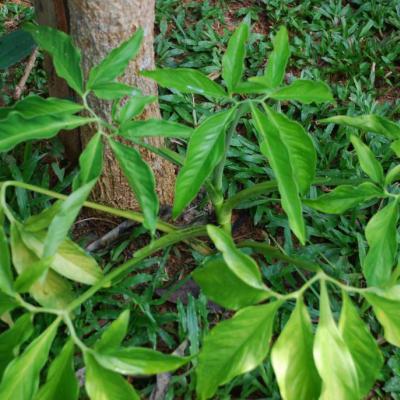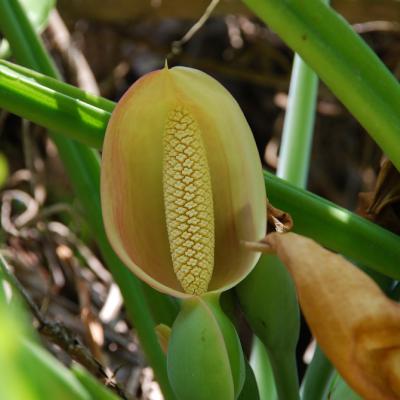Araceae-Syngonium-podophyllum
Classification
- Botanical Family : Araceae
- Genus : Syngonium
- Epithet : podophyllum
- German Family Name: Aronstabgewächse
- English Name: Arrow Head Plant
- Thai Name: เงินไหลมา
- Thai Phonetic: Ngön lai ma
- Author: Schott.
Water Requirements
Plant Type
Light Requirements
Cultivation
A special feature of this plant is that the leaves of young plants has a different shape than the leaves of older specimens. The leaves of young plants are arrow-shaped, green with white pattern and undivided. The leaves of older plants are divided, green without any pattern.
Flowering period is all year round. The flowers have the typical shape of Araceae. They are cream colored to yellow.
The plant makes no special demands on the soil type, but need regular water to keep the soil moist all the time.
The plant can be kept as a potted plant or in vase, where they drive roots.
Propagation: by cuttings (cuttings from older trees have divided leaves).
The juice of this plant is poisonous. It causes skin irritation in contact with skin. If consumed the raw parts of the plant it causes irritation in the mouth, lips, throat and tongue.
Syngonium podophyllum ist eine Kletterpflanze und Bodendecker. Sie wächst gern an Baumstämmen oder Säulen empor, die dann auch meistens rundum dicht eingehüllt werden. Hat die Pflanze keine Möglichkeit zu klettern, breitet sie sich sehr stark am Boden aus, so dass sie auch als niedriger Bodendecker geeignet ist. Sie wächst sehr schnell und kann als Kletterpflanze bis armdicke Ausläufer erreichen. Ohne regelmäßiges Ausdünnen oder Rückschneiden kann die Pflanze invasiv wachsen, das heißt, dass sie alles überwuchern kann.
Eine Besonderheit dieser Pflanze ist, dass die Blätter einer jungen Pflanzen eine andere Form hat, als die Blätter älterer Exemplare. Die Blätter der jungen Pflanze sind pfeilförmig, grün mit weißer Maserung und ungeteilt. Die Blätter von älteren Pflanzen sind geteilt und grün ohne Maserung.
Blütezeit ist das ganze Jahr über. Die Blüten haben die typische Form von Aronstabgewächsen. Sie sind cremefarbig bis gelb.
Die Pflanze stellt keine besonderen Ansprüche an die Bodenart, braucht aber regelmäßig Wasser, um den Boden ständig feucht zu halten.
Die Pflanze kann auch als Topfpflanze gehalten werden oder in Vasen, wo sie Wurzeln treiben.
Vermehrung: durch Stecklinge (Stecklinge von älteren Exemplaren haben bereits geteilte Blätter).
Der Saft dieser Pflanze ist giftig. Er verursacht bei Hautkontakt Hautreizungen. Bei Einnahme bewirkt er Reizungen im Mund, auf Lippen, im Rachen und auf der Zunge.
Origin
Miscelaneous
Ethnomedical uses
The ethnomedical information is provided for general information only, it is not intended as guidance for medicinal use.
One study has shown that Syngonium podophyllum possesses an anti-inflammatory activity. (1)
(1) Screening of the topical anti-inflammatory activity of some Central American plants S. Sosaa, M.J. Balickb, R. Arvigoc, R.G. Espositod, C. Pizzad, G. Altiniera, Aurelia Tubaroa, a DEMREP, University of Trieste, Via A. Valerio 6, 34127 Trieste, Italy b Institute of Economic Botany, The New York Botanical Garden, Bronx, NY 10458-5126, USA c Ix Chel Tropical Research Foundation, Cayo District, San Ignacio, Belize d Department of Pharmaceutical Sciences, University of Salerno, Via Ponte Don Melillo, 84084 Fisciano, Salerno, Italy Accepted 13 March 2002. Available online 24 April 2002. http://dx.doi.org/10.1016/S0378-8741(02)00080-6,
Volksmedizinische Verwendung
Die Berichte über volksmedizinische Verwendung ist nur zur allgemeinen Information und nicht als medizinischer Ratgeber zu betrachten.
In einer Studie wurde nachgewiesen, dass Syngonium podophyllum eine anti-inflammatorische Aktivität besitzt. (1)
(1) Screening of the topical anti-inflammatory activity of some Central American plants S. Sosaa, M.J. Balickb, R. Arvigoc, R.G. Espositod, C. Pizzad, G. Altiniera, Aurelia Tubaroa, a DEMREP, University of Trieste, Via A. Valerio 6, 34127 Trieste, Italy b Institute of Economic Botany, The New York Botanical Garden, Bronx, NY 10458-5126, USA c Ix Chel Tropical Research Foundation, Cayo District, San Ignacio, Belize d Department of Pharmaceutical Sciences, University of Salerno, Via Ponte Don Melillo, 84084 Fisciano, Salerno, Italy Accepted 13 March 2002. Available online 24 April 2002. http://dx.doi.org/10.1016/S0378-8741(02)00080-6,


